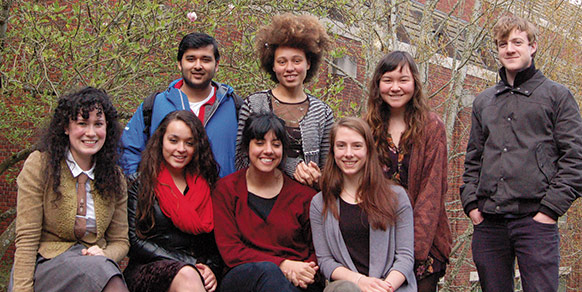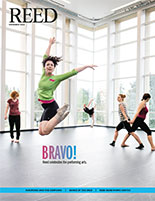
IRIS login | Reed College home Volume 92, No. 4: December 2013
Eliot Circular
Vanquishing Those Summertime Blues

Seated: Hannah MacKenzie-Margulies ’15, Sophie Naranjo-Rivera ’14, Maria Frodeman ’15, Sarah Tiffany-Appleton ’14. Standing: Vasishth Srivastava ’14, Jo Stewart ’14, Maria Maita-Keppler ’15, Lukas Ovrom ’14.
President’s fellowship helps students make more of their summers.
By Randall S. Barton
Everyone loves those lazy, hazy, crazy days of summer, but for many students, the three-month break between spring and fall classes represents an unparalleled chance to try something more ambitious.
As one of his first major initiatives, President John Kroger—who spent his summers at Yale doing menial minimum-wage jobs—decided to establish a President’s Summer Fellowship as a way of encouraging Reedies to think big over the summer.
“My one ambition for this fellowship is that it will help transform talented students’ lives,” says President Kroger. “We’ve got a very formal curriculum, and I wanted to create a way for students to spend a summer following a passion and preparing for their future.”
Kroger turned to trustee Dan Greenberg ’62 and his wife, Susan Steinhauser, who generously agreed to fund the program for the next five years. As a result, eight lucky students were awarded $5,000 each to spend the summer on a project that combines intellectual pursuit with imagination.
Apocalyptic Treasure Hunt
French major Lukas Ovrom ’14 spent the summer in Paris studying a medieval French manuscript for clues to its place of origin—and ultimately its author.
Lukas focused on the second of 29 texts in a 13th-century manuscript catalogued as BNF Manuscript 375 at the Bibliothèque nationale de France. Descriptively titled Explication of the Apocalypse, this second text is a glossed version of the New Testament’s “Book of Revelation.”
“Written in Old French, L’Explication has been ignored for the most part,” he says. “My goal was to use the dialectical and religious content of the text to figure out where the base manuscript for this particular version was written.”
His first hurdle was learning to read medieval calligraphy. He had picked up some Old French in a medieval French literature course he took with Prof. Ann Delehanty [French 2000–] and acquired more during a year abroad year studying in Rennes.
Because vellum (made from calfskin) and parchment (made from sheepskin) were expensive, scribes abbreviated common terms like “when.” To further confound comprehension, there was no differentiation between the letters u, v, and n.
“Scribes were the ones that actually circulated and copied all of these texts,” Lukas explains, “and they modified them at liberty and used their own dialect. Because of certain linguistic markers, grammar, and spelling it was possible to determine the manuscript was mostly assembled in a province called Picardy.”
At least 21 regionally specific dialects were spoken in France when the manuscript was copied in 1288. Lukas made a breakthrough when he located another copy of L’Explication at the British Royal Library. The two manuscripts showed several key differences. The French manuscript contained a prologue that replaced the first eight verses of the British version. It also contained clues indicating that the opening texts were not a part of the original manuscript. There was a difference in the color of the pages, the style of calligraphy, and dialect. It appeared that the scribe who wrote the first three texts was different from the ones who wrote the rest of the manuscript. Lukas made a tenable connection between the prologue and a prominent 12th-century copyist, Gilbert de la Porrée, bishop of Poitiers.
“It was something of a treasure hunt,” he says, “and really exciting. I was daunted for sure, but never bored.”
Documenting a revolution
In the 1980s her father came to the U.S. from Cuba on the Mariel boatlift. After President Fidel Castro resigned in 2008, sociology major Sophie Naranjo-Rivera ’14 realized that the generation that lived through Cuba’s revolution was aging out. Now that it’s legal for Americans to visit family members in Cuba, Sophie seized the opportunity to reconnect with a long-restricted heritage.
“The generation that lived through the Cuban revolution will be gone, taking their stories with them,” she writes on Works & Days, the student blog maintained by the Center for Life Beyond Reed.
Sophie traveled to Cuba and documented the stories of Cubans who lived through the revolution in the ’50s.
She found a beautiful tropical landscape and an impoverished but egalitarian society. “The country doesn’t have money,” she wrote, “but they have a lot of other things right.”
Sophie hopes to make future trips to Cuba to gain more perspective and assemble the information in a book or movie.
Making woodprints in Japan
Growing up in Eugene, Oregon, art major Maria Maita-Keppler ’14 attended a Japanese immersion school and lived in a home filled with the food, music, and traditions of her Japanese-born mother. Thanks to the President’s Summer Fellowship, she was able to travel to Japan and explore what she has long seen as the apotheosis of the Japanese aesthetic: woodblock printing.
She studied with artist Richard Steiner, who has been teaching and making woodblock prints for more than 20 years in a studio near downtown Kyoto. Not only did he agree to take on Maria as a pupil, he also found her an economical place to stay.
The experience taught Maria to appreciate the Japanese attention to detail and subtlety in all art forms. “Because Kyoto is such an old city, you have all the contemporary aspects of Japan right on top of these world heritage sites,” she says. “You see the old art juxtaposed against what’s new and flashy. It really made the richness of the old tradition stand out.”
Maria plans to teach the art of woodblock printing in Portland public schools. She is grateful not only for the experience that the fellowship provided, but also for the trust it placed in her.
“They tell you, ‘The project may not turn out the way you think it will, but that’s okay,’ which takes a lot of pressure off the student,” she says. “You are encouraged to fully immerse yourself in the experience.”
Here’s what the other fellows did:
Philosophy major Maya Frodeman ’15 worked in a microbiology lab near Paris.
Anthropology major Hannah MacKenzie-Margulies ’15 explored the work of choreographer William Forsythe at the San Francisco Conservatory of Dance.
Political science major Vasishth Srivastava ’14 worked in the research department at the Democratic Senatorial Campaign Committee in Washington, D.C.
English major Jo Stewart ’14 did an internship at the Paris Review and edited a journal featuring work by Reed students, faculty, and staff.
Studio art major Sarah Tiffany-Appleton ’14 volunteered with Architecture for Humanity Portland, a nonprofit that empowers communities in need by facilitating sustainable design solutions.

LATEST COMMENTS
steve-jobs-1976 I knew Steve Jobs when he was on the second floor of Quincy. (Fall...
Utnapishtim - 2 weeks ago
Prof. Mason Drukman [political science 1964–70] This is gold, pure gold. God bless, Prof. Drukman.
puredog - 1 month ago
virginia-davis-1965 Such a good friend & compatriot in the day of Satyricon...
czarchasm - 4 months ago
John Peara Baba 1990 John died of a broken heart from losing his mom and then his...
kodachrome - 7 months ago
Carol Sawyer 1962 Who wrote this obit? I'm writing something about Carol Sawyer...
MsLaurie Pepper - 8 months ago
William W. Wissman MAT 1969 ...and THREE sisters. Sabra, the oldest, Mary, the middle, and...
riclf - 10 months ago